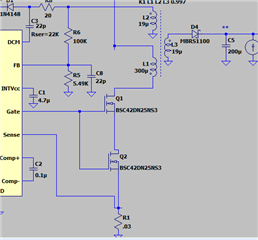- Ask a related questionWhat is a related question?A related question is a question created from another question. When the related question is created, it will be automatically linked to the original question.
This thread has been locked.
If you have a related question, please click the "Ask a related question" button in the top right corner. The newly created question will be automatically linked to this question.
Tool/software:
I would like to assume driving two MOSFETs in series without a pulse transformer using a single PWM IC (UCC28711). In this case, if the parasitic components of the PCB and the parameters of the MOSFETs are assumed to be identical, that is, in an ideal case, will the voltage distributed across the MOSFETs be evenly split into 1/2 during turn off in a flyback converter?
The image has been created for reference to aid understanding, and the PWM IC I will be using is the 28711.

Here, Q1 and Q2 are operated simultaneously by a single PWM IC as per my intention in the question.
Hello,
You cannot drive FETs in series this way.
One way to drive the high side FET as you mentioned is to use a gate drive transformer.
I do understand that you don't want to use that method.
The other method is to use a half bridge driver to drive the high side and low side FETs. The UCC27714 will work for this application.
https://www.ti.com/lit/ds/symlink/ucc27714.pdf
The other option is to use an isolated gate drive for the high side. The following link will get you to the high side gate drive folder. https://www.ti.com/power-management/gate-drivers/isolated-gate-drivers/products.html
If you have any questions on how to use the UCC27714 in your application or how to use one of the isolated gate drivers in your application, please repost in the e2e with the driver part number in the thread title. This is so the appropriate applications engineer can answer your questions.
Thank you for interest in Texas Instruments (TI) products. If you have a related question, please click the "Ask a related question" button in the top right corner. The newly created question will be automatically linked to this question.
Regards,